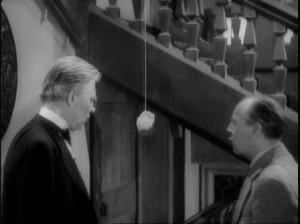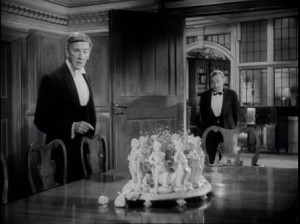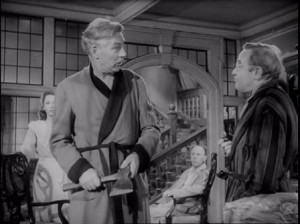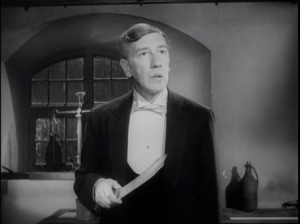The main theme of the score was composed—let’s say “used”—by Castelnuovo-Tedesco, a Jewish-Italian who fled anti-Semitism in Axis Italy and came to the United States in 1939. Not only the theme of the main title and an essential ingredient of the score, the melody doubles as source music—played on the piano by the adventurer and whistled by the murderer in the film’s climax. The tune, of course, is not the film composer’s own, but the third theme from the first movement of Mozart’s Piano Quartet No. 1 in G Minor, K. 478.
 For the numerous views of crashing waves and scenes on the island’s beach, the composer provides appropriate “sea” music, atmospheric strings and airy woodwinds. In the opening scene, he finds, too, just the right touch in a soft undulation to accompany the droning putt-putt of the motorboat as the guests are ferried to the island. And later, when the camera follows, across the floor, the trail of an unraveled ball of twine, his music is a misleadingly simple preamble to the discovery of the latest victim, the spinster.
For the numerous views of crashing waves and scenes on the island’s beach, the composer provides appropriate “sea” music, atmospheric strings and airy woodwinds. In the opening scene, he finds, too, just the right touch in a soft undulation to accompany the droning putt-putt of the motorboat as the guests are ferried to the island. And later, when the camera follows, across the floor, the trail of an unraveled ball of twine, his music is a misleadingly simple preamble to the discovery of the latest victim, the spinster.
Castelnuovo-Tedesco’s film scoring history is a muddled one. He is given credit for films he did not score and denied credit for ones he did score, mainly because most of his contributions were minimal, assisting the main composer or doing patchwork assignments to meet cramped studio schedules. This kind of work is hardly ever credited. The Mozart notwithstanding, And Then There Were None is one of the few films where he is credited on screen, albeit not on a solo card. Even under his name in the Internet Movie Database he is denied credit for scoring this film.
 He is best known for his “The Prophets” Violin Concerto and for several concertos for guitar.
He is best known for his “The Prophets” Violin Concerto and for several concertos for guitar.
Back to the plot. After depositing eight individuals on the dock at Indian Island, the boatman (Harry Thurston) gives the butler Rogers a note with instructions from Mr. Owen and returns to the mainland, not to return until Monday—when it will be too late for most of the ten inhabitants. The guests have discovered the “Ten Little Indians” nursery rhyme in each of their rooms and, on the dining room table, a circle of ten ceramic Indian boys.
First thing, the note instructs Rogers to play a phonograph record after dinner. From what then would have been a shellac disc, the booming voice of Mr. Owen accuses each of the ten people of various murders. Calling it all a joke, the old general removes the disc from the player and throws it across the floor. It rolls to the feet of—the judge, who picks up the record and reads the label: “Swan Song.”
The Russian, also an alcoholic, forever toasting someone or something, is the first to confess that he did, indeed, kill two people in an automobile accident. “Beastly bad luck,” he quips. As he lifts his glass—“Here’s to crime!”—he clutches his throat, staggers robot-like and collapses dead on the floor. Auer’s acting here, with an outstretched, clawing hand, is quite bad, as if he’s trying to be funny, especially after his hilarious monkey imitation years earlier in My Man Godfrey.
A lmost immediately, a ceramic Indian figure is found missing, and this is the scheme of things as, progressively, the guests are found dead, next the cook, the general, then the butler, the order and method of their demise matching the fate of the little Indians in the rhyme. Rogers, for example, was out chopping wood before he is found the next morning with his head split open with an axe. Thus: “Seven little Indian boys chopping up sticks,/One chopped himself in half and then there were six.”
lmost immediately, a ceramic Indian figure is found missing, and this is the scheme of things as, progressively, the guests are found dead, next the cook, the general, then the butler, the order and method of their demise matching the fate of the little Indians in the rhyme. Rogers, for example, was out chopping wood before he is found the next morning with his head split open with an axe. Thus: “Seven little Indian boys chopping up sticks,/One chopped himself in half and then there were six.”
And Then There Were None is surprisingly well paced, though probably not frantic enough for today’s audiences. There is no violence and views of dead bodies are quite discreet and antiseptic; with no way of disposing of the dead, since that launch won’t be returning until after the weekend, the victims are stashed in various rooms and promptly ignored. On at least one occasion, however, a character forgets and blindly enters a room. “Oh! It’s the general,” the detective remarks indifferently.
 The plot moves from serious distress to tongue-in-cheek melodrama to humor and one-liners. When the doctor suggests that the first death could have been suicide and the second an accidental overdose of medicine and adds “ . . . but this knife, which you saw me remove from the back of the third victim, means only one thing—murder,” there’s a clap of thunder and a flash of lightning from beyond the window. All in the best tradition of the old murder mystery. When the men have searched the house and the island for the murderer without success, the judge declares, “Mr. Owen is one of us!” And, sure enough, there’s another clap of thunder. With everyone drenched from a downpour, the adventurer observes, “All we have to do is keep quiet and we’ll hear him sneeze.”
The plot moves from serious distress to tongue-in-cheek melodrama to humor and one-liners. When the doctor suggests that the first death could have been suicide and the second an accidental overdose of medicine and adds “ . . . but this knife, which you saw me remove from the back of the third victim, means only one thing—murder,” there’s a clap of thunder and a flash of lightning from beyond the window. All in the best tradition of the old murder mystery. When the men have searched the house and the island for the murderer without success, the judge declares, “Mr. Owen is one of us!” And, sure enough, there’s another clap of thunder. With everyone drenched from a downpour, the adventurer observes, “All we have to do is keep quiet and we’ll hear him sneeze.”
Wonderful cast. Thoroughly enjoyable movie. Why did they ever think that remakes would be better than the original?
They did not think that, only to repeat, as much as possible, a former success. And probably for that reason alone the new version came up empty.
Grand movie but the picture quality on my dvd is so poor its almost unwatchable which is a huge drag. Would like to see a restored version please if anyone is listening. Walter Huston had real presence in all he did on film. For a Canuck he had a lot of character.